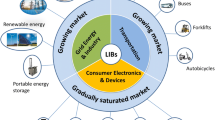Abstract
The performance of a battery–electrical double layer capacitor (EDLC) hybrid power source at low ambient temperature has been experimentally analyzed. EDLC can enhance the performance of lead-acid battery as it acts as a buffer during charging and discharging, and plays more significant role at low temperature than room temperature. The behaviors of current and voltage of both battery and EDLC have been detailed studied, and described by a mathematical model. With EDLC assistance, the battery can maintain longer discharge duration at −25 and −10 °C, compared with the battery alone. Adding an EDLC in parallel with the battery exhibits a considerable capacity increase compared to battery standalone in continuous discharge processes: from 13.6 to 36.5 %, corresponding to 25 to 200 A. These improvements of capacity become even more significant at low temperature. The increases in available capacity of different pulse duty, amounted to 72, 58, and 4 % at 0.1, 0.5, and 0.9 duty cycle values, compared to the capacity measured at constant current rate, respectively (calculated by 50 A discharge).
















Similar content being viewed by others
References
Kötz R, Carlen M (2000) Electrochim Acta 45:2483
Carter R, Cruden A (2008) In: International Symposium on Power Electronics, Electrical Drives, Automation and Motion, 2008. SPEEDAM 2008, p 727
Crolla DA, Ren Q, Eldemerdash S et al. (2008) In: IEEE Vehicle Power and Propulsion Conference 2008, VPPC ‘08, p 1
Onar O, Khaligh A (2008) In: IEEE Vehicle Power and Propulsion Conference 2008, VPPC ‘08, p 1
Holland CE, Weidner JW, Dougal RA et al (2002) J Power Sources 109:32
Smith TA, Mars JP, Turner GA (2002) In: The 33rd Annual IEEE Power Electronics Specialist Conference, p 124
Bode H (1977) Lead-acid batteries. Wiley, New York
Flores R, Blanco LM (1999) J Power Sources 78:30
Omar N, Van Mierlo J, Verbrugge B et al (2010) Electrochim Acta 55:7524
Bentley P, Stone DA, Schofield N (2005) J Power Sources 147:288
Caumont O, Le Moigne P, Rombaut C et al (2000) IEEE Trans Energy Convers 15:354
Peukert W (1897) Elektrotechnische Zeitschrift 27:287
Catherino HA, Burgel JF, Shi PL et al (2006) J Power Sources 162:965
Pascoe PE, Anbuky AH (2002) J Power Sources 111:304
Cooper A, Moseley PT (2003) J Power Sources 113:200
Author information
Authors and Affiliations
Corresponding author
Rights and permissions
About this article
Cite this article
Zhang, G., Zhao, X., Wang, B. et al. Enhanced performance of hybrid power source under low temperature. J Appl Electrochem 42, 399–407 (2012). https://doi.org/10.1007/s10800-012-0413-5
Received:
Accepted:
Published:
Issue Date:
DOI: https://doi.org/10.1007/s10800-012-0413-5




